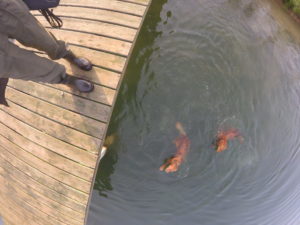
The closest I get to porpoises.
If you talk to dog trainers who are familiar with clicker training, almost all of them have heard of Karen Pryor. Her book on teaching, Don’t Shoot the Dog is not specifically about dogs. It is considered a “classic” book on dog training. Her less-known book, Lads Before the Wind, is one of my favorite books about training.
This book is set about 60 years ago at Sea Life Park in Hawaii and is fairly autobiographical. The subtitle is “Diary of a Dolphin Trainer.” It’s not a how-to. Karen Pryor came into an opportunity to take a short manual on training and apply that training. She was a facility initially designed to research behavior of cetaceans. There are parts that are uncomfortable to read due to animal care and welfare standards changing over time. But there are also a lot of parts that are amazing. I absolutely love the sense of adventure as they problem-solved through many scenarios with very different species.
Discovery
Her team wasn’t following a lot of set training plans and was creating their own goals. Early on, the facility decided to have two shows to the public. One that was more entertainment to bring in visitors. This show would highlight how amazing the animals are and to help visitors learn about the natural history of the area. The other show was demonstrations or actual training that was happening for research purposes. This would demonstrate research projects such as training related to echolocation. It seems so smart they would balance between what guests wanted to see and what the facility wanted to do.
The team was constantly experimenting. They were taking the concepts in their manual and finding ways to use those concepts to reach specific goals. Shaping of behaviors. Adding cues. Creating technology and props and materials to meet their needs.
They were doing things that hadn’t been done before so there was not a lot to build off of. And without the magic of the internet, talking to other professionals involved travel, phone calls or mail.
Interesting People
 One of the things that stands out in this book are the interesting people mentioned. Some are “big names” in ethology and behavior. The version I have has a forward by Konrad Lorenz who is an important person and one of the big names in every ethology textbook. BF Skinner visited. Quite a few of the people referenced maybe were important at the time but are not frequently referenced now in training/ethology. Things change over time!
One of the things that stands out in this book are the interesting people mentioned. Some are “big names” in ethology and behavior. The version I have has a forward by Konrad Lorenz who is an important person and one of the big names in every ethology textbook. BF Skinner visited. Quite a few of the people referenced maybe were important at the time but are not frequently referenced now in training/ethology. Things change over time!
Karen Pryor really did well with highlighting the people that made up this period of her life. Her descriptions of the personalities, interactions, and involvement of so many different people make parts of this read like a story.
Interesting Animals
The animals are just as much part of the story. Some she mentions in passing and other individuals appear for many chapters. At times the team wasn’t even sure of the species they were working with! At this time they were discovering what the animals were capable of and what was realistic to expect.
Most of the book is about the porpoises but there are moments about the training of various birds, horses, dogs, pigs, and other animals they had the opportunity to work with. This is such a beautiful example of how the basic concepts are the same even if the animals are physiologically very different.
Interesting Training
It’s so, so cool to read about the team taking the manual and applying the concepts of shaping behavior, varying the rate of reinforcement, adding cues, and working on stimulus control. These are some of the “basics” but are really challenging for many people working professionally with animals.
Karen Pryor didn’t have success always – the book also mentions areas where they had challenges and shares the creative attempts, the solutions, and the times where they didn’t reach full success (loosing an animal when working in the open ocean!).
I’m also inspired when I read about the technology and devices they created to be able to reach their training goals. They didn’t have what they needed, so it was created. Not always easily or immediately – but with experimentation they found appropriate solutions. Harnesses for the porpoises and ways to blind fold them. Props for doing presentations or work. Speakers (to play cues) that would work even with the salt water.
Conclusion
Lads Before the Wind was originally published in 1975 and it’s amazing to think about all the ways animal welfare and training have changed over time, as well as what Karen Pryor has been able to create with her business.
The book inspires me to train and experiment to see if I can find better ways to get a specific goal. There are a lot of training “recipes” that exist now and many of them work well overall or work well if a team has a specific foundation. But maybe there are more ways or more efficient ways to get there. If I don’t have a prop that I need, maybe there’s a way I can create it.
And…training comes down to our basic concepts of shaping, cues, and stimulus control.